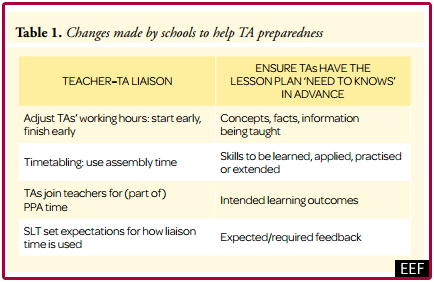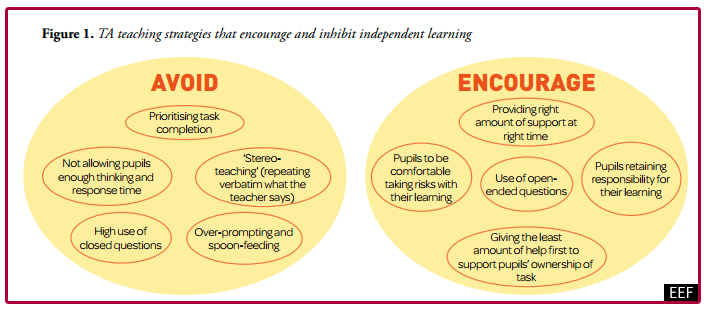 This article is written by Gary King, Assistant Principal at Tavistock College. It was originally posted on his own blog.
This article is written by Gary King, Assistant Principal at Tavistock College. It was originally posted on his own blog.
TEACHING assistants are in my opinion, without a doubt, the unsung heroes of the teaching profession. It really annoys me if I hear teaching assistants referred to simply as ‘support staff’, they are much, much more than this.
Although some may not have a degree nor QTS, they are still highly effective and thoroughly trained (making the assumption a school places value on CPD) in what they do. Without effective teaching assistants many of our students would find accessing learning challenging to say the least, and it’s down to teachers to utilise teaching assistants effectively.
Last year the Education Endowment Foundation (EEF) released a report summarising extensive research carried out exploring the impact of teaching assistants linked to student learning gains. As a teacher, ask yourself; do I ever get the opportunity to co-construct learning with the teaching assistant(s) I work with? Do I give clear direction but at the same time give autonomy to teaching assistants in order to add value to what I do in the classroom?
I appreciate that a large proportion of this will depend upon time and also the educational context in which we are working, for example this will be significantly different in a primary setting compared to that of a secondary school. However, I think it’s fair to say that there is most certainly variation in how teaching assistants are trained and deployed effectively in schools up and down the country.
This is a leadership dilemma that I’m sure many schools are experiencing – time constraints and the balancing act of prioritising the endless external directives and in-house initiatives, whilst at the same time aiming to be mindful of the workload burden.
Nevertheless, schools must find creative ways to make this happen, after all, we get one chance to make a difference and EVERY student matters. There are a number of strategies that we as school leaders can consider, this table, extracted from the EEF guidance report outlines some of the more proven and effective approaches for what is termed as ‘preparedness’:

“Presently, a quarter of the workforce in mainstream schools in England is comprised of TAs: 34% of the primary workforce, and 15% of the secondary school workforce. On the basis of headcount data, there are currently more TAs in English nursery and primary schools than teachers: 257,300 vs. 242,3002 . About 15% of TAs in publicly funded schools have higher-level teaching assistant (HLTA) status.”
With this evidence in mind, the question or challenge is; how can we plan effectively for teaching assistants to enhance the work of the teacher and accelerate students learning gains? The DISS project suggests:
“the majority of TAs spend most of their time working in a direct, but informal, instructional role with pupils on a small group and one-to-one basis (both inside and outside of the classroom). Results were also clear about which pupils TAs worked with. TA support was principally for pupils failing to make expected levels of progress, or those identified as having a Special Educational Need (SEN). TAs hardly ever supported average or higher attaining pupils.”
This is worrying, and only supports the ‘velcro TA’ model, which has been proven to create over-dependence and breed a reliance culture in students, and reinforces the associated stigma not to mention the financial implication.
Historically in education we have accepted the velcro TA as a way to take care of certain students whilst the teacher can concentrate on teaching the rest of the class. I fear that could be something that still exists in some schools and for the record something I disagree with immensely.

Here’s a suggested checklist to integrate TAs, ensure they enhance the work of the teacher, and fully prepare them for their role in the classroom:
- Share scheme(s) of learning and the ‘big picture’ to identify formative and summative assessment points (end point tasks).
- Professional development opportunities; focus on pedagogical approaches which underpin quality first teaching. This of course will be driven by an explicit analysis of a school’s teaching and learning model, you can read more about this here in a previous blog I wrote.
- Equip teachers with the appropriate skills and preparation time to help them manage the teaching assistants they work with.
- Allow teaching assistants quality time to share practice with their peers, professional learning isn’t an exclusive club just for teachers.
- Involve teaching assistants in assessment, cross mark and moderate where possible. This will offer enormous experience to support the delivery of high quality small group intervention within the classroom.
- Encourage teaching assistants to be active in lessons, this is essential in raising their profile in the classroom.
- Meet regularly and keep the professional working relationship fresh and informed.
- Something to think about: To what extent are teaching assistants included in and play a part in delivering professional learning?
It is essential that we do not use teaching assistants as a substitute for teachers of low-attaining pupils or for those that who are categorised as ‘Pupil Premium’.
Dialogue is key
Dialogue between teachers and students is integral to quality first teaching and learning with questioning as key. Therefore it is crucial to develop the pedagogical role of a teaching assistant, as their communication with pupils will tend to be predominantly verbal more than anything else.
This is potentially the most important element in their practice, therefore it is essential that teaching assistants benefit from the same professional development opportunities that teachers have receive.
The DISS project research has uncovered that many pupils have much longer and more in-depth interactions with teaching assistants than with their teachers. This research has also provided evidence that teaching assistants are far more inclined to prompt students, instead of allowing them time to think.
Their approach tends to concentrate on ensuring tasks are completed, frequently supplying the answers to make sure this is achieved. On the other hand, a teacher knows how to use effective questioning that will support students learning and promote learning gains via deep thinking skills.
Again, all this points to the quality of a schools professional development model and what extent this includes or excludes teaching assistants.
“TAs help ease teacher workload and stress, reduce classroom disruption and allow teachers more time to teach”
Schools have to define the role of teaching assistants, valuing their contribution in driving whole school improvement. On a day-to-day basis, it’s ultimately the relationship you have with your teaching assistant(s) that is crucial and key to collaborative high impact approaches, ensuring that all students make accelerated learning gains.
Tavistock College is part of the SSAT network. Find out more about membership here.
